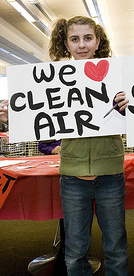Study: Less Smog Means Healthier Kids
 Up to this point almost all studies about air pollution have tracked increasing levels of air pollution with decreasing levels of health. Respiratory problems, strokes, heart disease, Autism, Parkinson's-like symptoms – they've all been linked to exposure to high levels of air pollution vs exposure to less severe air pollution.
Up to this point almost all studies about air pollution have tracked increasing levels of air pollution with decreasing levels of health. Respiratory problems, strokes, heart disease, Autism, Parkinson's-like symptoms – they've all been linked to exposure to high levels of air pollution vs exposure to less severe air pollution.
Now, comes a new study that approaches the problem from the opposite end of things. It associates healthier kids, specifically, increased lung capacity, with cleaner air over time in Southern California. It provides much needed evidence that pollution controls mandated by the Clean Air Act over the last 40 years have had their intended effect and improved public health.
On Wednesday, the results of the effort were published in the New England Journal of Medicine by researchers from the Keck School of Medicine at the University of Southern California (USC).
Over two decades, researchers at USC studied air pollution levels as they declined in five smog-plagued local communities, while also measuring breathing capacity in 2,120 school children from those same communities during three separate time periods: 1994-1998, 1997-2001 and 2007-2011.
The last group of kids tested showed improved lung growth of about 10% between the ages of 11 and 15, compared with children at the same age in 1996. Overall, the percentage of children with abnormally low lung function at age 15 dropped from nearly 8% in 1994-98, to 6.3% in 1997-2001, to just 3.6% in 2007-11. The positive effects were observed in boys and girls, and regardless of race and ethnicity.
This increase in lung function tracks with improvements in air quality in the LA Basin. According to the ALA, despite a higher population and more cars, Los Angeles had 68 fewer high-ozone days last year than in 1996, and 75 fewer high-particulate-matter days than in 2000. By the study’s conclusion in 2011, fine particulates had fallen by 50 percent and nitrogen dioxide levels by 35 percent in the communities being studied.
Those communities had fewer bad air days because of the pollution controls introduced by government beginning in the mid 1970's with the introduction of the automobile catalytic converter, and continuing to this day with emissions restrictions on everything from shipyards to power plants to lawn mowers.
According to the USC study, those controls and the decrease in smog they produced, have led to fewer stunted lungs and fewer children susceptible to asthma and a host of other respiratory disorders.
According to USC's James Gauderman,
“Improved air quality over the past 20 years has helped reduce the gap in lung health for kids inside, versus outside, the LA basin.”
Consensus in the scientific community (outside TCEQ) seems to suggest that this kind of study wil be important in proving the efficacy of new pollution controls across the country.
Morton Lippmann, a professor of environmental medicine at New York University School of Medicine, said the research would be influential and predicted that within the next few years, when federal emission standards are due for review, “this kind of information will play a major role.”
“It provides confirmation that the work we’ve done to improve air pollution has made a difference in kids’ health,” said Dr. Joel Kaufman, a physician and epidemiologist at the University of Washington, who was not involved in the research. “There are more kids comfortable running around.”
The caveat here is that while new controls benefited public health, it was not necessarily the controls on ozone pollution alone that caused the benefits. During the two decades of study, ozone levels declined only modestly. Ozone has been associated with acute health problems, such as asthma attacks, but the researchers concluded that its reduction does not have the long-term effects on overall lung function that reductions in fine particulates and nitrogen dioxide do.
Pollution controls for ozone, or smog, often have the side effect of reducing particulate matter (PM) and NO2 (one of the forms of Nitrogen Oxide that form ozone), as well. It may well be that these side effects have more impact on public health than previously believed. Certainly the accumulating evidence about the variety of insidious harms caused by even low levels of particulate matter exposure give credence to this idea. Based on the scientific literature, many local downwinders have believed that the single most dangerous kind of pollution being emitted by the cement plants in Midlothian are their voluminous amounts of PM pollution.
One of the reasons Downwinders at Risk has been so insistent on getting Selective Catalytic Reduction (SCR) on the kilns is that, besides being able to reduce NOX pollution by 80-90 % or more, the equipment is also able to make sizable dents in Dioxins, Volatile Organic Compounds, and yes, Particulate Matter pollution.
